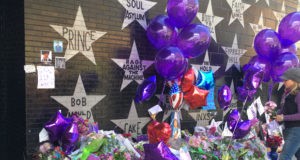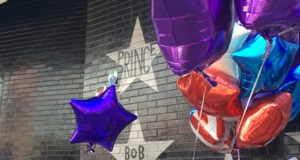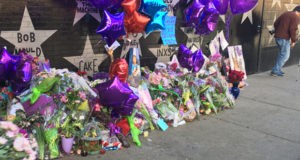
For me, his death hits me on a different level. Like lots of people my age, whether at Bar and Bat Mitzvah parties, or USY and BBYO conventions, our tween/teen years spanned what is among the greatest runs of hits by one artist. Prince was our soundtrack: “1999,” “Little Red Corvette,” “Delirious,” the entire “Purple Rain” album, “Raspberry Beret,” “Kiss,” among lots of others. The best way to get a bunch of awkward teens dancing at a Bar Mitzvah party in the 1980s? Start playing “Let’s Go Crazy.” The organ starts and then we all finished the opening line along with Prince. Plus, his songs were favorites in the lip sync contests.
Prince also became a star at the same time as MTV, which for you Millennials, is a cable TV station that used to play music videos. That meant the energy and sexuality that he brought to his music was on your television as well.
 There was also a “danger factor” to him. It wasn’t just the music of “Purple Rain” that excited us at that time, but the fact that seeing the movie required some serious sneaking around to see. I saw it at a friend’s house thanks to their older brother putting it on. Nobody’s parents were letting you see that movie, unless they had no idea what it was about. Most of the music we probably shouldn’t have been listening to either, for that matter. Think I’m wrong? Go look up the lyrics to “Darling Nikki.”
There was also a “danger factor” to him. It wasn’t just the music of “Purple Rain” that excited us at that time, but the fact that seeing the movie required some serious sneaking around to see. I saw it at a friend’s house thanks to their older brother putting it on. Nobody’s parents were letting you see that movie, unless they had no idea what it was about. Most of the music we probably shouldn’t have been listening to either, for that matter. Think I’m wrong? Go look up the lyrics to “Darling Nikki.”
He had a penchant for pushing the edge with lyrics, content and costume. While the latter may have been tame for today’s era, he went on American Bandstand in 1979 in high-heeled boots, tight gold pants and an unbuttoned shirt. The boots became a staple, although not because he lacked height, he said, but because women liked them.
For Minnesotans, correct me if you think I’m wrong here, but I think the appeal to Prince isn’t just that he’s a born and raised Minnesotan: It’s that he stayed. Dylan left. Soul Asylum left. The Replacements, while impactful, didn’t have the longevity.
 “Growing up in Minneapolis – especially in the public school system – Prince served as the living, breathing, screaming, dancing, daring, and outlandish contradiction to stereotypes of “Minnesota nice” and Midwestern mush,” Minneapolis native and rabbi at Temple Adath Israel in Lexington, Ky., David Wirtschafter wrote this week.
“Growing up in Minneapolis – especially in the public school system – Prince served as the living, breathing, screaming, dancing, daring, and outlandish contradiction to stereotypes of “Minnesota nice” and Midwestern mush,” Minneapolis native and rabbi at Temple Adath Israel in Lexington, Ky., David Wirtschafter wrote this week.
Wirtschafter wrote that Prince was about defying expectations and assumptions. Prince was shorter than 5-feet tall, but his stage presence and incredible music ability at virtually any instrument were second to none.
“He defied categorizations of race, gender, sexuality, musical genre – you name it,” Wirtschafter wrote. He learned musicianship from Cornbread Harris (father of famed composer and producer Jimmy Jam Harris) and at the MacPhail Center for the Arts, the same downtown center where my brother, sister, daughter, and I all took violin lessons. ”
As for Prince’s Jewish community connections in the Twin Cities, he’s got those that go well past a band or DJ playing his music at a Bar Mitzvah party. He was born at Mount Sinai Hospital, drummer Bobby “Z” Rivkin and keyboardist Matt Fink were long-time members of Prince’s band The Revolution are from St. Louis Park and Wirtschafter wrote that one of Prince’s very first business associates in the music business was Amos Heilicher, for whom the Minneapolis Jewish Day School is named.
There are not a lot of big musicians that come out of Minneapolis. Prince could have left for anywhere else in the world, but decided to set up shop in Chanhassen and regularly open his doors to the masses for impromptu concerts and dance parties. It’s that he stayed which endeared him to the masses.


1 comment